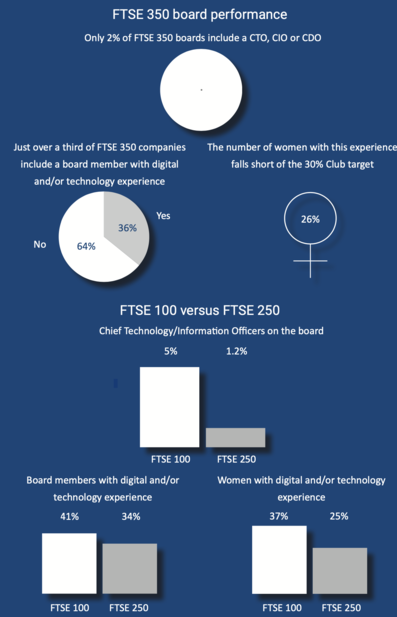Tech-tonic Shift
Foreword
By Cathy Kay, Managing Partner – Commercial, Russam
It’s become almost trite to say that technology is changing the world faster than ever before. But it is a profound and inescapable fact, and one that many of us are yet to comes to terms with. Though we may think that digital transformation has had its moment, some of the most dramatic changes are likely to lie ahead – just think of 3D
printing, robotics, connected homes and smart cities. Not to mention the innovations we don’t yet know are coming.
We say this now because the UK already lags behind other economies in its readiness to compete in the digital economy, and many companies are known to be struggling to adapt.2 It also lags behind its G7 counterparts when it comes to productivity, and embracing new technologies is a key driver of that measure.3 As Richard Branson
himself has observed: “When the digital revolution took place … a lot of companies simply digitalised their current methods of working, rather than taking steps to really adapt.”
The research undertaken for this report shows that only 2% of FTSE 350 companies have a technology specialist on the board. For 98% there is therefore no guarantee that this voice will be heard or heeded at the most senior level.
This is troubling at a time when the UK must consider its future outside the European Union. In a matter of years, UK companies will be out there on their own, competing with former partners for a share of the market. They will need to go armed with world-beating ideas, many of which will flow through technology. With workplace
transformation coming hot under the government spotlight too, fundamental questions about corporate governance are amplifying this discussion.
Companies have a choice: set the pace with technological improvements (and at the very least keep pace) or risk eroding their relevance on a global stage.
We need only remind ourselves of Kodak to grasp the dangers of getting left behind. A former heavyweight in the analogue film business, it failed to go digital and eventually went bankrupt, replaced by competitors like Canon and Hewlett Packard. Ironically, Kodak did in fact invent the first ever digital camera; but this revolutionary new
technology was kept in the dark for fear of cannibalising film sales.
It is an example that teaches us about the ingredients of success: the greatest technological advances in the world will mean nothing at all without the vision and will to apply them. It also brings to our attention that power belongs to those who see possibilities before they become obvious to everyone else.
So how do you drive a company that is ready to embrace and adapt to technological change?
We believe that boards should include a Chief Technology Officer who can master the present and future trends of technology and convince the rest of the organisation to change. We are not advocating for each and every company to appoint a CTO to their board instantaneously; an organisation needs to be ready to accept someone
into that role. But the direction of travel has been set and those who stand to benefit in the longer term will be planning how to advance along the technology journey today.
This paper recommends a variety of strategies which aim to facilitate a level of company readiness and board readiness to embrace digital technology as a commercial and strategic driver; to forge ahead rather than keep up or, worse still, lag behind. It advocates measures, such as establishing a digital transformation committee, running regular innovation workshops or appointing an interim change manager, to help pave the way.
Introduction
Every business is dependent on its environment. How one adapts internal strategies to cope with the perceived pressures will rest on its innate strength: the financial, physical and human resources available at its command. A company with strong financial reserves, for example, is less vulnerable to market fluctuations than one without.
It’s the job of the board to ensure that the company finds and stays in a position of strength so that it can compete. This requires having a deep and active understanding of the patterns and forces that affect company
performance, while being vigilant of circumstances on the horizon.
Technological opportunity and threat isn’t looming – it’s already here. With breakthroughs introducing change into every industry, it is the predominant issue moving up the company roster. Done right, it can boost operational efficiency, improve customer and employee satisfaction, and increase overall productivity.
The question is: are you the disruptor or are you the disrupted? Some will prefer hesitation and wait for others to take the lead, doing something only when they can no longer do nothing. Others will take a more dynamic approach, seeing change as an inevitable feature of any business and preparing a strong hand. It doesn’t take
much to guess whether reaction or pro-action will reap the reward.
“Companies are reluctant to make the first move. They save a bit of money by going in afterwards and not making the same mistakes that others have made. But not being an early adopter brings risk.”
Cathy Kay, Managing Partner – Commercial, Russam
It’s evident that many companies are struggling. Where some might normally be ahead of the crowd in adapting to change, they see a yawning and disturbing gap between the inherent value of technology and the capacity to make it work effectively. It is sophisticated. It is fast moving. And it is pervasive. At a time of intense global
competition, leaders are battling with how to manage their resources to deal with the extent of technological application, the choice of systems and processes, the need for specialist skills and experience, and cultural resistance to change.
We believe it is only a matter of time before every company assigns a Chief Technology Officer to lead this ongoing development, and before that position should then earn board status. Technology is a company-wide issue, like finance or HR, and it is becoming increasingly urgent. This report explains what companies can do to prepare for now and the future.
Definitions
Throughout this paper we refer to “technology”, which can be both sustaining and disruptive, and is always digital. No single role, like Chief Financial Officer, has evolved to take on responsibility for technology. Rather we see a range of roles – Chief Information Officer, Chief Technology Officer and Chief Digital Officer – growing up around it.
Here are two definitions we have picked up from our conversations which we like;
- Technology “enables” innovation and business inclusive solutions.
- A Chief Technology Officer or Chief Information Officer “translates” technology into robust systems within a business context.

Urgency
Technology is a fundamental business issue that requires urgent action. It directly impacts on the cost base of companies, how customers are managed, and the way in which internal systems and processes are operated. It is also a security concern, with two-thirds of big UK businesses experiencing a cyber-attack in the past year.
“Not embracing digital is a risk to the life of a business … your profitability will
suffer over time. You may be able to hold onto your lead for a while,
but it will come back to bite you.”
MB Christie, COO at Tech City UK
Responsibility for managing and driving technological change ultimately rests with the board. It is the job of the CEO, challenged by the Chairman and the rest of the board, to develop a structure and strategy that integrates technology into every aspect of the business, while creating a culture that encourages every member of staff to
embrace it.
But how urgently are boards addressing this potentially existential challenge?
Our research uses the boards of FTSE 350 companies as a proxy for beginning to answer this question. We can reveal that, despite the rising popularity of Chief Technology Officers (CTO), Chief Information Officers (CIO) and Chief Digital Officers (CDO)9, only 2% of FTSE 350 companies, including PayPoint, BHP Billiton and Hargreaves Lansdown, include this role on the board. Unsurprisingly perhaps, the FTSE 100 outperforms the FTSE 250 at 5% compared with 1.2%.
Why is this?
Using interviews with a number of industry leading experts across the professional services, insurance, technology and IT to build on existing research, a number of possible explanations have been uncovered. These are as follows:
- Lack of available talent.
- Tendency for this career to come up through information technology.
- Lack of awareness and understanding of technology.
- Reluctance of companies to change.
Companies are increasingly aware of the need for digital operations but do not feel ready. Half of British businesses surveyed by YouGov are fearful or worried about keeping pace with digital developments in the next five years.10 For some, a cultural mindset may be obstructing progress. MB Christie, CEO at Tech City UK, feels there remains “a lack of understanding about how fundamental the shift is”.
For others, a superficial focus on technology is failing to bring results. As Tony Henderson, EMEA Business Development Lead at Microsoft, explains: “Companies talk about innovation, but they rarely actually do it.” Even where companies feel they have managed to fill a perceived digital or technological skills gap, the individual in that
role often isn’t sufficiently skilled or senior enough to ensure that change takes root.
They may not have a dedicated CTO at board level, but looking at the biographies of all the FTSE 350 board members, a far greater number of companies (125) include someone with digital and/or technology experience. A good number therefore may have a level of expertise with which to assess technology issues.
However, 125 companies still only constitute 36%. (Again, the FTSE 100 surpasses the FTSE 250 with 41% versus 34%.) And even where a person’s skill or understanding is substantive, they are unlikely to be in a position to reach and influence the wider organisation. A significant majority are non-executive directors, who are by their
nature somewhat removed from day-to-day activities. Such an individual, though an important boost to the cause, cannot be expected to keep up with the rate of change in technology and the impact it has on consumer and organisational behaviour at ground level within a company.
Of course, a CTO or CIO may exist lower down in the company structure and feed into the board. In this instance, having a champion non-executive may make all the difference. Other companies may be addressing the issue in different ways.
But it’s important to remember that bringing in technology could constitute having to rethink fundamental business strategies and models, leaving all known upheavals in its wake. As such, someone with specialist skills is needed in a senior position to steer the company in the right direction – especially as the future pace of change is unlikely to be forgiving. An interim change manager might have the requisite knowledge and experience to move the business to the next level in preparation for a full-time CTO.
Boards that fail to embrace change and tackle it head on could pay the price later down the line. This means having the right mix of people around the table to make it happen.
“We can take it as read that, over the next five years, the pace of change will be at least as fast as the last”.
Justin Harrington, COO at HCL Insurance BPO Services

Diversity
So how do companies ensure the board is well-equipped to drive technological change? What do board members need to confidently deal with, invest in and respond to technology? What strategies are successful in opening them up to change? And how can they learn from disruptive companies and younger generations?
Part of the answer to these questions begins with diversity. Boards with a diverse leadership are better able to take on new knowledge of issues affecting the company and to avoid “group think”.
Cognitive science reveals that we are simply less interested in learning new skills the older we get. When we learn something new, our prefrontal cortex has to work especially hard to grapple with unfamiliar ideas. This becomes harder as we mature and our brains create mind maps that form quickly established habits. Reality increasingly conforms to past perceptions and we are limited in what we see.
Yet, despite the strength of this evidence, data shows that 80% of FTSE 350 board members are aged between 50–70. The average age of a chairman is 64 years old, of a NED is 60 years old and of an executive director is 53 years old.
We’re not saying that age is an indicator of obsolescence when it comes to driving innovation and a vision of how technology might transform a company and its products. Far from it. Age diversity is as critical as any other in spotting opportunities or countering threats. Seasoned board members might not be at the bleeding edge of
technological developments, but their insight into where a market might develop if technology is applied can be crucial.
Achieving a mix of ages is a good way to open up the board to change. And thinking about how different generations interact is better still. Experiential learning helps us break with long-established thought patterns. We see and feel new ways of doing things and don’t just read about them. Younger generations, who have a natural
technical ability, and those with specific digital experience and skill, can help show the way.
Of course, diversity applies to more than just age. Decades of research also show that diverse groups (that is, those with a diversity of race, ethnicity, gender and sexual orientation, as well as age and experience) are more innovative than homogeneous groups.
Again research reveals that we are neglecting the facts. Only 78 board directors – around 5% of the total in the FTSE 150 – come from Black, Asian or minority ethnic background. What’s more, less than 2% of those are British citizens.
The figures for gender diversity are considerably better, but it’s still the case that 61% of FTSE 350 and 45% of FTSE 100 companies have failed to hit the target of 25% female representation at board level.
Here our research indicates that we may have a small reason to celebrate. Two out of eight CTOs on FTSE 350 boards are female, reaching that 25% target. The statistic improves further to 29% when we look at the 125 companies with a board member who appears to have decent digital and/or technological experience – an
encouraging sign perhaps that technology is a more diverse field than some other areas of business. (Once again, the FTSE 100 demonstrates a stronger commitment than the FTSE 250, with 37% versus 25%.)
Diversity discussions essentially boil down to the same thing: the value of collaborative thinking. Getting people who know technology to share their insight with people who know companies and markets, and importantly understand how to persuade the board and other stakeholders that technology-driven change is crucial, is key.
Generations apart
Technological savviness is often drawn along generational lines. The younger generations are the digital natives; they have grown up with technology and have no trouble adapting to the newest gadget. The digitally naïve, on the other hand, tend to be the business leaders of today; the baby-boomers who are traditionally slower to take to the latest online tool. Tony Henderson, EMEA Business Development Lead
at Microsoft, points out that “cutting edge technology today belongs to those between 25 and 35” and that these individuals are “very rarely in senior roles”.
So how do companies make sure that the latest innovations surface at board level?
One answer lies in ensuring that younger generations are represented on boards. However, although there is merit in age diversity, treating this as a solution is potentially risky.
Recruiting a young person exclusively for this purpose provides an excuse to others not to engage with technology. It may also bring onto the board someone who has buckets of technical know-how but little in the way of broader business expertise. More dangerously, relying on this candidate runs the risk of perpetuating the generational divide, whereby all things digital are outsourced to the millennials while the older generations become increasingly irrelevant. Over time, our fixation on youth culture could leave older people out in the proverbial cold.
Such a policy wouldn’t be particularly sustainable, either. Throughout much of history, technological shifts have happened gradually and without too much cultural disruption. Today, the quick-moving nature of the digital world means that younger people are coming of age in a vastly different technological environment to those who came just before them. A company might recruit a young person to the board for their technical expertise, only to replace them in a few years’ time.
We would do better to avoid age restrictions and think of an openness to technology as freedom of thinking. As Cathy Kay, Associate Director at Russam GMS, describes it: “It’s not about age but about curiosity”. Because although senior members of a business have historically been late adopters compared with their younger co-workers, their movement into digital life continues to deepen and it is something we should encourage.
“I’m worried that we close down generations or over-rely on generations just because of age. I do think it’s more down to energy, interest, curiosity, open-
mindedness. I know 70-year-olds who are more energetic, more open, more into
diverse things than some 30-year olds. I hate to put people in boxes because
they’re x, y or millennial.”
Justine Shaw, People and Culture Director, Main Board Director, General Manager EU Region, CPP Group Plc
That’s not to say we should ignore younger generations at board level. Boards should spend more time listening to them, as should market research teams, for they are a vital demographic. Companies should also find ways to draw on their abilities and ideas to help educate and train older generations who may be less receptive to technology.
Culture
So how does a company convince the board that understanding the role of technology is an urgent matter of business? And how do you encourage a diverse workforce that will sit on and feed into the board? Here we find that everything must be supported and enforced by culture.
Companies are increasingly alert to company culture. After what we’ve seen at the likes of Volkswagen and FIFA, there is an acknowledged need for a continuous focus on culture to help mitigate the impact of crises, and support the company’s strategy and purpose. This requires evaluating what it is their company is doing in the round.
A healthy corporate culture is one in which employees work together to ensure the overall success of the business. In addition to traditional “hard” measures of corporate health, such as profit and return, a company’s culture affects human resource policies and practices, the nature of team interaction, the quality of business relationships
and its impact on the wider environment.
Company culture is driven by the CEO. It is his or her role to create a vision for the business, to set the management style and tone, and to harness the skills and enthusiasm of the rest of the team. A healthy culture must also be underpinned by strong governance, responsibility for which rests with the board.
Like any other aspect of the business, the CEO and board need to recognise and embrace the role of technology in forming the company culture. Together they need to be in a position to consider choices around the extent of digitisation and integration, and the new innovation opportunities enabled by it – be they related to the business
model, management or customer experience.
“The CTO can evangelise as much as they like, [if the business isn’t ready] all the old structures and the old ways will push back on them.”
Justine Shaw, People and Culture Director, Main Board Director, General Manager EU Region, CPP Group Plc

Finding the right ingredients
As Cathy Kay, Associate Director at Russam GMS, explains, it’s often the case that a CEO engages on a strategic level with technology only at certain times in the year when it becomes a priority; “it does not form part of a continual strategy conversation as it should”. The difficulty, she explains, is that technology is hard to monetise:
“no-one knows what the future holds … you can present proof of return, but you’d be guessing.”
That’s why every board needs a specialist technology voice on it; to drive a vision for technology, build evidence for it, and narrow the divide between an old way of thinking and a modern business view.
An individual in this role must have the right blend of technological capability and business-mindedness. In the words of Justin Harrington, COO at HCL Insurance BPO Services, “the CTO role has got to become almost a translator between technological capability and business requirement.”
“The people side is much harder than technology.”
Tony Henderson, EMEA Business Development Lead at Microsoft
This hasn’t always been the case. Many CIOs are former IT Managers who have moved up through the grades. As such, they are not necessarily trained in business leadership. This has resulted in an over-emphasis on technical ability, leaving the commercial part of the brief comparatively ignored.
“Technology has changed but the broader business capabilities of people in IT leadership roles has not moved on as quickly. So what you’ve got is a gap between what technology can do and how important it is, and the ability of technology leadership to explain that properly to boards and help them take advantage of it.”
Andy Tinlin, former Managing Director at Accenture Strategy UK & Ireland
However, this is beginning to change. A greater number of businesses are appointing CTOs who are different in nature from CIOs. “CTOs are less about hardware, infrastructure and databases. They’re not straight-line people; they’re all wiggly lines and cloud-shapes”, says Justine Shaw, People & Culture Director at CPP Group Plc. She
explains that it’s “a blend of tech/geek coupled with commercialism” that makes them so effective.
If the board isn’t ready to accept someone in this role but it does so anyway, then there’s a danger that others will feel there’s less onus on them to get with the programme. It’s not an excuse to forget all about it and concentrate on “core business”. This is where strategies like innovation workshops or appointing an interim change manager can help pave the way for a CTO board member in future.
The rest of the company has to be ready, too. A business cannot just appoint a CTO or CIO and give him or her a budget and a mandate to get on with it. As Justine Shaw, People & Culture Director at CPP Group Plc, explains: “If the business isn’t ready, then that individual cannot make a difference.” Here clarifying and communicating the
strategic vision for technology, accompanied by practical and interactive training, will inspire the wider team to consider how it might improve their working lives.
Conclusions &
Recommendations
Boards that fail to discuss the role of technology in the future of their company will fall behind as the world transforms around them. Avoiding this fate requires looking inwardly at the composition of the board and senior teams.
In the same way that finance and operations are critical enablers for a business to run well – reflected in positions at the top table – we believe that CTOs will become a universal fixture within company structures. But they cannot be expected to make a sincere and lasting difference without buy-in at board level and a wider organisational
culture to support them.
Individual companies will need to decide when they are ready to accept this role, and prepare the ground as soon as possible.
If a CTO or CIO does not exist, “The worst thing a company can do is to hire a guru whose role is to challenge and stimulate but who has no operational responsibility whatsoever, meaning that people can optionally listen to them or not (most often they choose not).”
Andy Tinlin, former Managing Director at Accenture Strategy UK & Ireland
Here we provide a range of options to suit different businesses, depending on their size, their readiness and what they want to achieve. Companies are unlikely to pursue all of the following strategies; instead the point is to consider which of these would open up the structure and culture of your business to change.

Board ready
Strategies to set expectations and support engagement at board level
-
- Appoint a CTO to the board with the right blend of technical know-how
and commercial sense who can drive the technology strategy. - Appoint an interim change manager who can help guide the company in
the direction of technological change and work closely with the CTO. - Establish a digital transformation committee to help rationalise, define
and design a technology strategy. - Recruit a non-executive with proven leadership in digital transformation
who can help carry the business case for technology. - Run innovation workshops for the board to educate and build the
confidence and enthusiasm of all members.
- Appoint a CTO to the board with the right blend of technical know-how
Company ready
Strategies to encourage agility so you can prepare and plan for the future
-
-
- Improve the clarity of the vision to inspire commitment and innovation
among the wider team. - Appoint a CTO with the right blend of technical know-how and
commercial sense who can drive the technology strategy. - Create a pipeline of talent and provide staff with training.
- Develop an ideas generation platform to allow bright thoughts to be
aired, sorted and taken forward. - Consider the criteria you are looking for in recruitment and whether you
need to formally include technological capability.
- Improve the clarity of the vision to inspire commitment and innovation
-
About Russam
Russam enables organisations and individuals to thrive. As the original pioneers of UK interim management and as specialists in executive search, we use our experience, depth of knowledge and networks to ensure that our clients succeed. There are four core strands to the Russam business: Interim Management, Permanent Appointments, Board Practices and Total Project Delivery. Our sector experts have extensive insight into the industries they serve, from finance and manufacturing to technology, the
public sector and not-for-profits. We work with ambitious start-ups to multinationals. We have a proven track record in providing the right professionals to deliver transformation, gap management, crisis management, business turnaround and rapid growth. In 2014 we co-founded the The WIL Group, giving us access to a global network and we also co-founded Step on Board and Trustees Unlimited (one of the
UK’s first B Corporations), putting us at the vanguard of chair, trustee and non-executive recruitment as well as talent development. We teach on the Cranfield NED Programme and through our delivery of Step on Board, work with senior leaders across firms including Deloitte, EY, Credit Suisse, Barclays, Bupa and Google.
Methodology and Contributors
We set out to discover how many firms in the FTSE 350 currently have a digital and/or technology specialist, such as a Chief Technology Officer, in their boardroom. We gathered quantitative data mainly from the London Stock Exchange and individual company websites. These findings were then augmented through detailed one-on-one interviews with individuals. The research was conducted in August 2016.
Our thanks go to the following people for their invaluable time and insight.
MB Christie, Chief Operating Officer at Tech City UK Justin Harrington, COO at HCL Insurance BPO Services Tony Henderson, EMEA Business Development Lead at Microsoft Justine Shaw, People and Culture Director, Main Board Director, General Manager EU Region, CPP Group Andy Tinlin, former Managing Director at Accenture Strategy UK & Ireland.
Notes
1. Barclays, From inclusion to empowerment: The Barclays Digital Development Index, 2016
2. Squiz, Digital Disruptors: Are UK businesses fit enough to survive?, 2016
3. The Guardian, May promises social reform in centrist leadership pitch, July 2016
4. The Telegraph, Branson: Never mind networking; technology will get you closer to customers, November 2014
5. The Guardian, UK productivity gap widens to worst level since records began, February 2016
6. Business Insider UK, This man invented the digital camera in 1975 — and his bosses at Kodak never let it see the light of day, August 2015
7. Squiz, Digital Disruptors: Are UK businesses fit enough to survive?, 2016
8. BBC News, Cyber-attacks: Two-thirds of big UK businesses targeted, July 2016
9. Comms Dealer, Chief Digital Officers on the rise in European businesses, July 2016
10. YouGov survey for Vodafone UK, 2015
11. Forbes, Why we’re so afraid of change – and why that holds businesses back, April 2013
12. Grant Thornton, Corporate Governance Review 2013: Governance steps up a gear, 2013
13. McKinsey & Company, Diversity matters, 2015
14. SpencerStuart, UK Board Index: Current board trends and practices at major UK companies, 2015
15. Equality and Human Rights Commission, An enquiry into fairness, transparency and diversity in FTSE 350 board appointments, 2016

Contact us
Call us on 07930 356305 or email HQ@russam.co.uk








